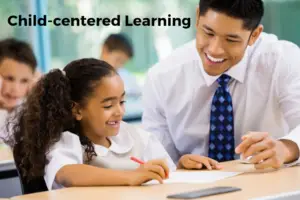Are you a teacher who is insearch of a teaching method that considers the needs of the child first? This article contains the information you seek.

Child-centered Teaching [3] approach, also known as student-centered or learner-centered approach, is an educational philosophy that places the child or learner at the center of the learning process.
It is a teaching method that focuses on each student’s individual needs and interests. This type of learning helps children feel valued and allows them to explore and learn independently. With child-centered learning, the teacher gets to know each student and creates activities and lessons tailored to their individual needs and abilities. This inturn makes learning fun and helps the children stay engaged and motivated.
In a nutshell, Child-centered teaching recognizes that each child is unique and learns in different ways, so it aims to create a learning environment that is responsive to the needs and interests of each child.
The goal of child-centered learning is to help kids become confident and independent learners who can think for themselves and enjoy the process of learning. It also helps them develop critical thinking, problem-solving, and creativity skills.
In a child-centered classroom, the child is encouraged to take an active role in their learning by choosing activities that interest them and working individually or in groups to explore their interests.
Features of Child-centered Teaching
There are certain features and characteristics [2] that make teaching a child centered one. Here are some of the basic features:
1. Active learning:

Child-centered teaching emphasizes hands-on, active learning experiences that engage children in the learning process. Children are encouraged to explore, experiment, and discover new concepts through varieties of activities such as games, experiments, projects, and field trips.
2. Student-led activities:
Child-centered teaching encourages children to take an active role in their learning by choosing activities that interest them and working independently or in groups to explore their interests. The teacher provides guidance and support, but the child is in control of their learning process.
In other words, the children with the teacher’s guidance are made responsible for constructing their own understanding.
3. Differentiated Instruction:
Child-centered teaching recognizes that each child is unique and learns in different ways, so instruction is tailored to meet the individual needs of each child. The teacher provides a variety of learning experiences and materials to support each child’s learning style and ability.
4. Collaborative learning:

While it’s a fact that child-centered teaching recognizes that every child is unique, it also recognizes that learning is a social process, and children learn best through collaboration and interaction with their peers. In a child-centered classroom, children work together to solve problems, share ideas, and learn from one another.
5. No Discrimination:
Child-centered education is above gender and economic and social background of the child. There is no place for discrimination of any kind in child-centered education. The teacher lays down uniform ways of behavior for children and gives them appropriate rewards when they do the same.
Application of Child-centered Teaching
According to getgoally [1], here are a few ways child-centered learning is applied:
1. Classroom Instruction
Teachers can use this approach to design lessons tailored to their student’s needs and interests.
2. After-school programs
Programs like tutoring or enrichment classes can use a child-centered approach to help kids learn in a way that is engaging and meaningful to them.
3. Montessori schools

The Montessori school applies a Child-centered learning approach [5]. It encourages children to explore and discover through hands-on activities.
4. Homeschooling
Home schooling is a more natural form of learning that gives parents full control over the direction of what their children learn. Parents who homeschool their children tend to use Child-centered learning to create a customized curriculum for each child.
5. Play-based learning
Oftentimes, early learning schools use the child entered teaching approach. They mainly focus on using play as a means of learning. This makes the child more interested to learn actively.
Advantages of Child-centered Teaching Approach
Child-centered teaching has many advantages over traditional teacher-centered approaches. Some of the advantages of child-centered teaching include:
1. Increased Engagement
Child-centered teaching actively engages the children in the learning process by giving them opportunities to explore their own interests and ideas. This can increase their motivation to learn, improve their academic performance and help them to develop a lifelong love of learning.
2. Improved Critical Thinking Skills
Child-centered teaching encourages scholars to ask questions, analyze information, and evaluate arguments. This can help them develop critical thinking skills that are essential for success.
3. Enhanced Creativity
Child-centered teaching fosters creativity and innovation by giving students the freedom to explore their own ideas and express themselves in their own way. This can help children develop skills that are highly valued.
4. Increased Collaboration
Child-centered teaching emphasizes the importance of collaboration and teamwork. By working together to solve problems and share ideas, children can learn from each other and develop important social skills.
5. Improved Self-Esteem
By placing the child at the center of the learning process, child-centered teaching helps to develop a child’s sense of autonomy and independence. Children are encouraged to take ownership of their learning and to develop their own ideas and interests. By doing so, they tend to build self confidence which helps to build their self esteem.
6. Encourages hands-on learning
Hands-on learning is an example of child-centered teaching. Hands-on learning allows young children to interact with the learning materials and make mistakes as they learn in a practical manner
Disadvantages of Child-centered Teaching Approach
While there are some benefits to this approach, there are also some disadvantages to consider. Some potential disadvantages of child-centered teaching approaches [4] include:
1. Lack of structure
Child-centered teaching approaches may be less structured than other traditional teaching approaches. Sometimes, this can lead to confusion and disorganization in the classroom. Without clear expectations and guidelines, students may be confused and struggle to understand what is expected of them and thus may not be able to stay focused on their learning.
2. Limited Teacher Control
In a child-centered classroom the teacher is more like a facilitator, learners are given more control over their learning, which means that the teacher may have less control over the direction and pace of the lesson. This can make it difficult for the teacher to ensure that students are meeting specific learning objectives.
3. Lack of Preparation for Standardized Tests
Since the Child-centered teaching approach is focused on ensuring that learners detect whatever and however they want to learn, according to heterodox academy [4.1] it has been established that students find exams stressful and so teachers are told to reduce the number of exams.
In this case, this approach does not prioritize the development of test-taking skills, which can be a disadvantage for students who need to take standardized tests. These tests often require students to be able to demonstrate specific knowledge and skills, which may not be emphasized in a child-centered classroom.
Scholars deserve opportunities for intellectual and academic challenge so that they develop the necessary strength of mind and character to meet the various challenges they will inevitably face at different times in life. Child centered teaching dampens such development.
4. Unequal outcomes
Child-centered teaching approaches may not be suitable for all children, and some may struggle to learn in this type of environment. This can lead to unequal outcomes, with some students succeeding while others fall behind.
5. Time-consuming

Child-centered teaching approaches often require more time and resources than other approaches, as they require teachers to tailor their instruction to the needs and interests of each individual learner. This can be challenging for teachers who are already stretched and have limited time to prepare for their lessons. As a result of this, teachers in general do not always want to use this approach.
CONCLUSION
Child-centered teaching approaches prioritize the needs and interests of the children, and aim to create a learning environment that is responsive to their individual needs.
The approach emphasizes active learning, collaborative learning, differentiated instruction, and student-led activities. Child-centered teaching helps to develop critical thinking, children’s autonomy, creativity, and problem-solving abilities,
In, child-centered teaching approaches have their benefits and drawbacks, and it is important for teachers to weigh these factors when deciding on the best approach for their classroom.
REFERENCES:
[1] Bagalan, Hennah. “Child-Centered Learning – Goally Apps for Autism & ADHD.” Goally Apps for Autism & ADHD, Goally Apps & Tablets for Special Needs, 6 Feb. 2023, https://getgoally.com/blog/neurodiversopedia/child-centered-learning/.
[2] Dushi, Gauri. “10 Essential Characteristics of Child-Centred Education.” Preservearticles.com: Preserving Your Articles for Eternity, 9 Jan. 2012, https://www.preservearticles.com/education/10-essential-characteristics-of-child-centred-education/17982
[3] Smile Foundation. “Importance of Child Centered Education.” Smile Foundation, 17 Feb. 2023, https://www.smilefoundationindia.org/blog/importance-of-child-centered-education/.
[4] “The Problem with Student-Centered Education.” Heterodox Academy, 11 Oct. 2022, https://heterodoxacademy.org/blog/the-problem-with-student-centered-education/.
[5] Gogreenva.org, https://www.gogreenva.org/the-montessori-method-a-child-centered-approach-to-education/.
Don’t miss out on current updates, kindly like us on Facebook & follow us on Follow @EAfinder OR leave a comment below for further inquiries.






